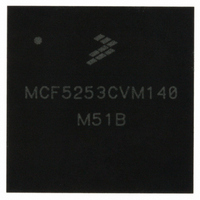MCF5253CVM140 Freescale Semiconductor, MCF5253CVM140 Datasheet - Page 399

MCF5253CVM140
Manufacturer Part Number
MCF5253CVM140
Description
IC MPU 32BIT 140MHZ 225-MAPBGA
Manufacturer
Freescale Semiconductor
Series
MCF525xr
Datasheets
1.MCF5253VM140J.pdf
(34 pages)
2.MCF5253VM140J.pdf
(8 pages)
3.MCF5253VM140J.pdf
(648 pages)
4.MCF5253VM140J.pdf
(2 pages)
Specifications of MCF5253CVM140
Core Processor
Coldfire V2
Core Size
32-Bit
Speed
140MHz
Connectivity
CAN, EBI/EMI, I²C, QSPI, UART/USART, USB OTG
Peripherals
DMA, WDT
Program Memory Type
ROMless
Ram Size
128K x 8
Voltage - Supply (vcc/vdd)
1.08 V ~ 1.32 V
Data Converters
A/D 6x12b
Oscillator Type
External
Operating Temperature
-40°C ~ 85°C
Package / Case
225-MAPBGA
Family Name
MCF5xxx
Device Core
ColdFire V2
Device Core Size
32b
Frequency (max)
140MHz
Instruction Set Architecture
RISC
Supply Voltage 1 (typ)
1.2/3.3V
Operating Supply Voltage (max)
1.32/3.6V
Operating Supply Voltage (min)
1.08/3V
Operating Temp Range
-40C to 85C
Operating Temperature Classification
Industrial
Mounting
Surface Mount
Pin Count
225
Package Type
MA-BGA
Lead Free Status / RoHS Status
Lead free / RoHS Compliant
Number Of I /o
-
Eeprom Size
-
Program Memory Size
-
Lead Free Status / Rohs Status
Compliant
Available stocks
Company
Part Number
Manufacturer
Quantity
Price
Company:
Part Number:
MCF5253CVM140
Manufacturer:
FREESCALE
Quantity:
300
Company:
Part Number:
MCF5253CVM140
Manufacturer:
Freescale Semiconductor
Quantity:
10 000
Part Number:
MCF5253CVM140
Manufacturer:
FREESCALE
Quantity:
20 000
Company:
Part Number:
MCF5253CVM140J
Manufacturer:
Freescale Semiconductor
Quantity:
10 000
- MCF5253VM140J PDF datasheet
- MCF5253VM140J PDF datasheet #2
- MCF5253VM140J PDF datasheet #3
- MCF5253VM140J PDF datasheet #4
- Current page: 399 of 648
- Download datasheet (8Mb)
20.4.1.2
20.4.1.2.1
The debug module implementation provides a common hardware structure for both BDM and breakpoint
functionality. Several structures are used for both BDM and breakpoint purposes.
the shared hardware structures.
The shared use of these hardware structures means the loading of the register to perform any specified
function is destructive to the shared function. For example, if an operand address breakpoint is loaded into
the debug module, a BDM command to access memory overwrites the breakpoint. If a data breakpoint is
configured, a BDM write command overwrites the breakpoint contents.
20.5
In addition to the existing BDM commands that provide access to the processor’s registers and the memory
subsystem, the debug module contains nine registers to support the required functionality. All of these
registers are treated as 32-bit quantities, regardless of the actual number of bits in the implementation. The
registers, known as the debug control registers, are accessed through the BDM port using two new BDM
commands: WDMREG and RDMREG. These commands contain a 4-bit field, DRc, which specifies the
particular register being accessed.
These registers are also accessible from the processor’s supervisor programming model through the
execution of the WDEBUG instruction. Thus, the breakpoint hardware within the debug module may be
accessed by the external development system using the serial interface, or by the operating system running
on the processor core. It is the responsibility of the software to guarantee that all accesses to these resources
are serialized and logically consistent. The hardware provides a locking mechanism in the CSR to allow
the external development system to disable any attempted writes by the processor to the breakpoint
registers (setting IPW = 1). The BDM commands must not be issued if the ColdFire processor is accessing
the debug module registers using the WDEBUG instruction.
Freescale Semiconductor
Debug Module Memory Map and Register Definitions
Register
Debug Module Hardware
ABHR
AATR
Reuse of Debug Module Hardware (Rev. A)
DBR
Bus Attributes for All Memory Commands
Address for All Memory Commands
Data for All BDM Write Commands
Table 20-18. Shared BDM/Breakpoint Hardware
MCF5253 Reference Manual, Rev. 1
BDM Function
Address for Address Breakpoint
Attributes for Address Breakpoint
Data for Data Breakpoint
Breakpoint Function
Background Debug Mode (BDM) Interface
Table 20-18
identifies
20-29
Related parts for MCF5253CVM140
Image
Part Number
Description
Manufacturer
Datasheet
Request
R
Part Number:
Description:
Mcf5253 Coldfire? Microprocessor Data Sheet
Manufacturer:
Freescale Semiconductor, Inc
Datasheet:
Part Number:
Description:
Manufacturer:
Freescale Semiconductor, Inc
Datasheet:
Part Number:
Description:
Manufacturer:
Freescale Semiconductor, Inc
Datasheet:
Part Number:
Description:
Manufacturer:
Freescale Semiconductor, Inc
Datasheet:
Part Number:
Description:
Manufacturer:
Freescale Semiconductor, Inc
Datasheet:
Part Number:
Description:
Manufacturer:
Freescale Semiconductor, Inc
Datasheet:
Part Number:
Description:
Manufacturer:
Freescale Semiconductor, Inc
Datasheet:
Part Number:
Description:
Manufacturer:
Freescale Semiconductor, Inc
Datasheet:
Part Number:
Description:
Manufacturer:
Freescale Semiconductor, Inc
Datasheet:
Part Number:
Description:
Manufacturer:
Freescale Semiconductor, Inc
Datasheet:
Part Number:
Description:
Manufacturer:
Freescale Semiconductor, Inc
Datasheet:
Part Number:
Description:
Manufacturer:
Freescale Semiconductor, Inc
Datasheet:
Part Number:
Description:
Manufacturer:
Freescale Semiconductor, Inc
Datasheet:
Part Number:
Description:
Manufacturer:
Freescale Semiconductor, Inc
Datasheet:
Part Number:
Description:
Manufacturer:
Freescale Semiconductor, Inc
Datasheet:











